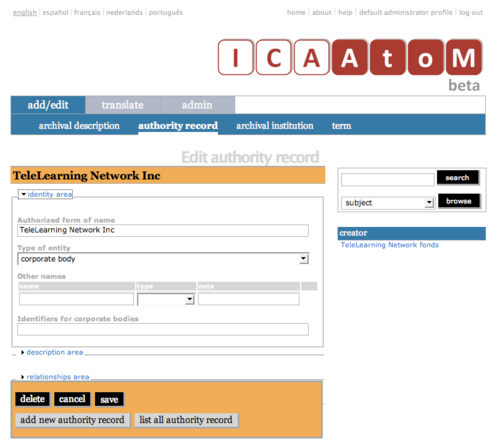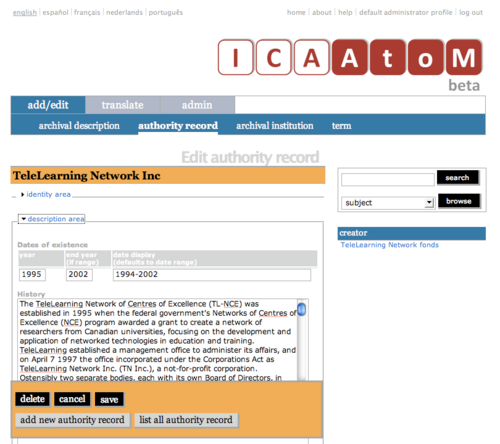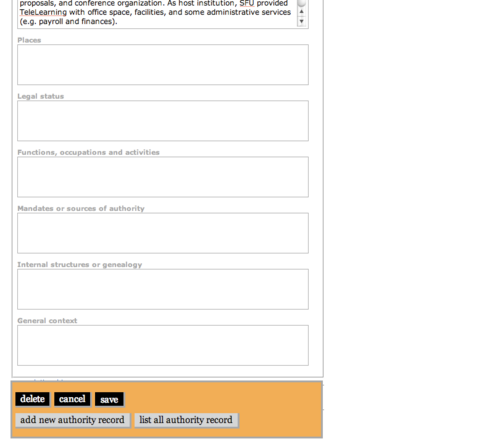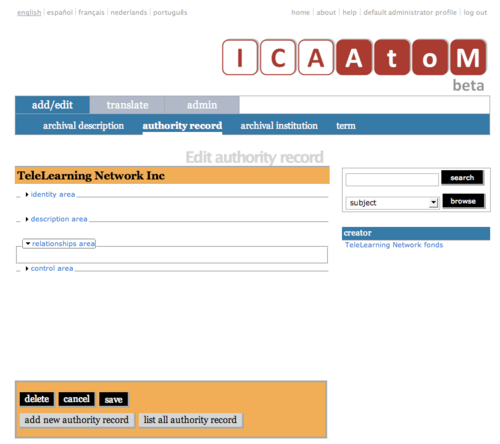Difference between revisions of "Add a new authority record"
| Line 120: | Line 120: | ||
== Control area == | == Control area == | ||
| − | The ''Control area'' contains fields for information about the creation and maintenance of the authority record itself. This [[ | + | The ''Control area'' contains fields for information about the creation and maintenance of the authority record itself. This [[Information area|information area]] has been standardized in ICA-AtoM for [[Archival description|archival descriptions]], [[Authority record|authority records]], and [[Archival institution|archival institutions]] and is described on a separate page: |
*See [[UM-3.4|Data entry: control area]]. | *See [[UM-3.4|Data entry: control area]]. | ||
Revision as of 15:13, 11 June 2008
Please note that ICA-AtoM is no longer actively supported by Artefactual Systems.
Visit https://www.accesstomemory.org for information about AtoM, the currently supported version.
Data entry: authority records
Main Page > (UM) User manual > UM-3 Add / edit content > UM-3.2 Add / edit authority records > UM-3.2.1 Data entry: authority records
The Edit screen for authority records is structured into four information areas following the ICA's International Standard Archival Authority Record for Corporate Bodies, Persons and Families (ISAAR(CPF), 2nd edition, 2004).
Click on a information area to expand it (display fields); click again to collapse it (hide fields). Note that as of the current version of ICA-AtoM (v1.0 beta), whenever you save a record ICA-AtoM re-loads the page, which collapses all areas.
The following notes aim primarily to clarify ICA-AtoM procedures; for guidelines on what information to record in particular fields, consult ISAAR(CPF) as the content standard. The notes are organized by field, with links to the applicable ISAAR section(s). Where there is a one-to-one correspondence between an ISAAR element and an ICA-AtoM field, the note simply gives the ISAAR rule verbatim.
Identity area
The Identity area contains fields for information "which uniquely identifies the entity being described and which defines standardized access points for the record" (ISAAR(CPF) 4.4.1).
1. Authorized form of name
- "Record the standardized form of name for the entity being described in accordance with any relevant national or international conventions or rules applied by the agency that created the authority record. Use dates, place, jurisdiction, occupation, epithet and other qualifiers as appropriate to distinguish the authorized form of name from those of other entities with similar names. Specify separately in the Rules and/or conventions element (5.4.3) which set of rules has been applied for this element." (ISAAR(CPF) 5.1.2)
2. Type of entity
- "Specify the type of entity (corporate body, person or family) that is being described in this authority record." (ISAAR(CPF) 5.1.1)
- ICA-AtoM ships with a drop-down menu using a default (taxonomy of types; the three core types (corporate body, person, family) cannot be removed or edited, but editors or administrators can add new types.
3. Other names
- Multi-value field for registering and displaying alternate names for the entity.
- Register as many names as you need.
- The last row in the list contains text boxes for data entry.
- Enter the alternate name in the Name field, select the Type of name from the drop-down list, and add any explanatory text if required in the Note field.
- When you save the record, ICA-AtoM registers the other name and displays it in the list above the data entry field.
- Repeat and save to register additional names.
- To delete an entry, click the Delete icon.
- For rules and examples, see (ISAAR(CPF) 5.1.3, 5.1.4 and 5.1.5).
4. Identifiers for corporate bodies
- "Record where possible any official number or other identifier (e.g. a company registration number) for the corporate body and reference the jurisdiction and scheme under which it has been allocated." (ISAAR(CPF) 5.1.6)
Description area
The Description area contains fields for information "about the nature, context and activities of the entity being described" (ISAAR(CPF) 4.4.2). With the exception of date-related fields (see steps 1-3 below), all fields are basic text fields.
1. Dates of existence
- "Record the dates of existence of the entity being described. For corporate bodies include the date of establishment / foundation / enabling legislation and dissolution. For persons include the dates or approximate dates of birth and death or, when these dates are not known, floruit dates. Where parallel systems of dating are used, equivalences may be recorded according to relevant conventions or rules. Specify in the Rules and/or conventions element (5.4.3) the system(s) of dating used, e.g. ISO 8601." (ISAAR(CPF) 5.2.1)
2. Year and End year
- Enter the start and end years of the entity.
- Leave End year blank if the entity is still in existence.
- Use four-digit numbers only.
- Do not use qualifiers (e.g. "ca.") or typographical symbols (e.g. "[197-]") to express uncertain dates.
- Start and end values will be used in searches (earlier than, later than) and sorting.
3. Date display
- Enter dates of existence as a date range (yearX - yearY).
- Add any qualifiers (e.g. "ca.", "predominant") and typographical symbols as required.
- This is the value that will appear in view mode as the Dates of existence.
4. History
- "Record in narrative form or as a chronology the main life events, activities, achievements and/or roles of the entity being described. This may include information on gender, nationality, family and religious or political affiliations. Wherever possible, supply dates as an integral component of the narrative description." (ISAAR(CPF) 5.2.2)
5. Places
- "Record the name of the predominant place(s)/jurisdiction(s), together with the nature and covering dates of the relationship with the entity." (ISAAR(CPF) 5.2.3)
6. Legal status
- "Record the legal status and where appropriate the type of corporate body together with the covering dates when this status applied." (ISAAR(CPF) 5.2.4)
7. Functions, occupations and activities
- "Record the functions, occupations and activities performed by the entity being described, together with the covering dates when useful. If necessary, describe the nature of the function, occupation or activity." (ISAAR(CPF) 5.2.5)
8. Mandates or sources of authority
- "Record any document, law, directive or charter which acts as a source of authority for the powers, functions and responsibilities of the entity being described, together with information on the jurisdiction(s) and covering dates when the mandate(s) applied or were changed." (ISAAR(CPF) 5.2.6)
9. Internal structures or genealogy
- "Describe the internal structure of a corporate body and the dates of any changes to that structure that are significant to the understanding of the way that corporate body conducted its affairs (e.g. by means of dated organization charts). Describe the genealogy of a family (e.g. by means of a family tree) in a way that demonstrates the inter-relationships of its members with covering dates." (ISAAR(CPF) 5.2.7)
10. General context
- "Provide any significant information on the social, cultural, economic, political and/or historical context in which the entity being described operated." (ISAAR(CPF) 5.2.8)
Relationships area
The Relationships area contains fields for documenting relationships between the current entity and other corporate bodies, persons and/or families (ISAAR(CPF) 4.4.3).
- This information area has not yet been implemented as of ICA-AtoM v0.6.
Control area
The Control area contains fields for information about the creation and maintenance of the authority record itself. This information area has been standardized in ICA-AtoM for archival descriptions, authority records, and archival institutions and is described on a separate page:




